What sound do owls make? Owls make a variety of sounds, from the classic “hoo” to whistles, screeches, and even barks. Streetsounds.net is your ultimate resource for exploring the diverse soundscapes of the avian world. Discover the unique calls of different owl species and learn how to identify them, enhancing your understanding and appreciation of nature’s symphony. Dive into our extensive library of owl vocalizations, explore insightful articles, and connect with a community of passionate sound enthusiasts on streetsounds.net, where every hoot, whistle, and screech tells a story.
1. Understanding the Essentials of Owl Sounds
Owls use sounds for a multitude of reasons, mirroring the vocal communications of other birds. These reasons include claiming and defending territories, attracting mates, and maintaining contact with each other. However, identifying owl calls is especially crucial due to their nocturnal nature, making them easier to hear than to see.
According to research from the Cornell Lab of Ornithology, owl vocalizations are complex and varied, often specific to the species and even the individual owl. Understanding these nuances can greatly enhance our ability to identify and study these elusive birds.
While owl sounds are commonly associated with Halloween, their cultural and historical importance extends far beyond a spooky night. In many Indigenous cultures in North America, hearing an owl’s call is considered a bad omen. Harriet Tubman famously used imitations of owl calls as signals on the Underground Railroad.
Owls typically claim territories and find mates during the winter months, making January and February the best times to hear them. However, owl sounds can be heard year-round, especially at dawn and dusk when their active periods overlap with ours. Always remember to maintain a respectful distance if you’re fortunate enough to encounter one, as owls can be sensitive to human disturbance.
2. Eastern Screech-Owl Vocalizations
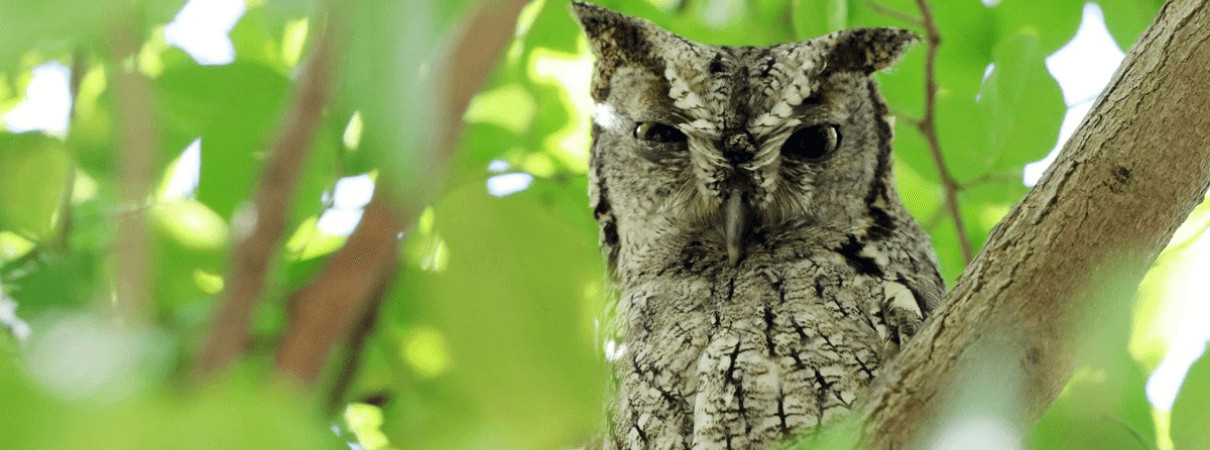 Eastern Screech Owl by Jesus Franco
Eastern Screech Owl by Jesus Franco
Eastern Screech-Owls have two primary calls. One is a descending, horse-like whinny, which they use to defend their territories. The other is an extended trill on a single pitch, used to attract mates and maintain contact with family members. These owls are common and thrive in suburban neighborhoods but are declining in some areas. You can listen for these little owls almost anywhere in the U.S. east of the Rockies.
According to a study by the U.S. Geological Survey, Eastern Screech-Owl populations are facing increasing pressure from habitat loss and urbanization. Identifying and understanding their calls is essential for monitoring and conservation efforts.
3. Decoding the Barred Owl’s Call
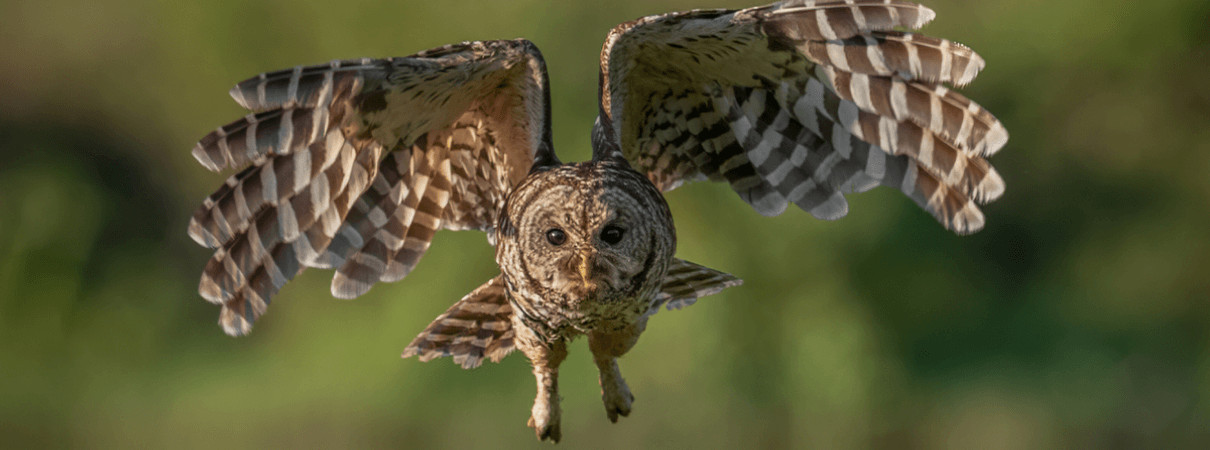 Barred Owl by Harry Collins Photography/Shutterstock
Barred Owl by Harry Collins Photography/Shutterstock
Ask any birdwatcher about the sound of a Barred Owl, and they’ll likely respond with, “Who cooks for YOU? Who cooks for YOU all?” However, when a pair starts to duet, it often devolves into what Birds of the World describes as “a raucous jumble of cackles, hoots, caws, and gurgles.” Unlike many other owls, the Barred Owl is frequently heard during the day and at night. These vocal birds are common in the eastern U.S. and have moved into the Northwest, competing for habitat with the Threatened “Northern” Spotted Owl.
The expansion of Barred Owls into the Northwest is a significant ecological concern, as highlighted by research from the Audubon Society. Their aggressive competition with Spotted Owls underscores the importance of understanding their behavior and vocalizations.
4. The Quintessential Hoot of the Great Horned Owl
Great Horned Owl sounds are often used in TV shows and movies, making it the quintessential hooting owl of the United States. Found throughout North and South America, these owls are common and adaptable to various habitats, including cities. However, breeding bird surveys in North America indicate a gradual decline, with numbers dropping by around 33 percent over the past five decades.
Research from the Smithsonian Migratory Bird Center indicates that Great Horned Owl populations are affected by habitat fragmentation and pesticide use. Monitoring their vocalizations can provide valuable data on their distribution and population trends.
5. The Bloodcurdling Shriek of the Barn Owl
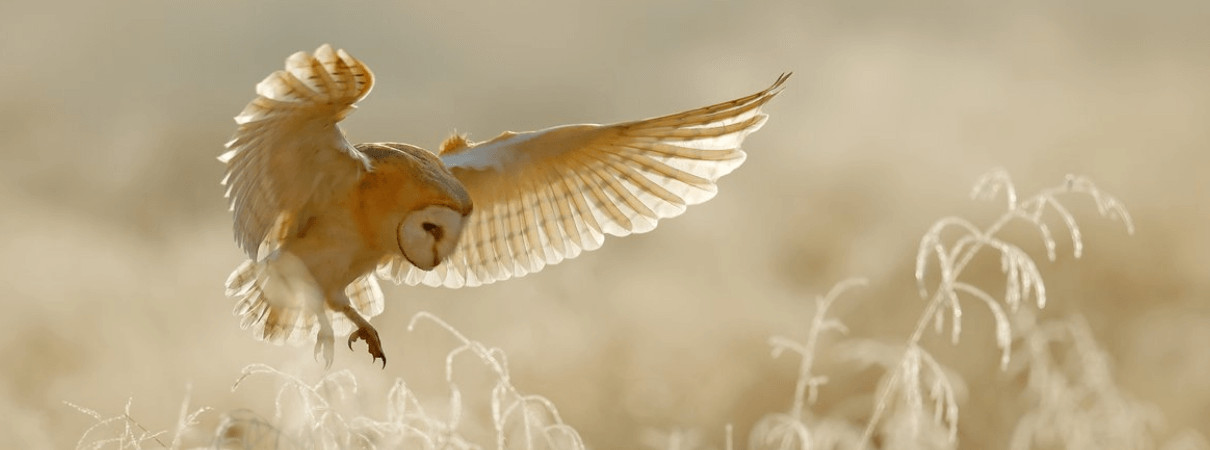 Barn Owl by Ondrej Prosicky/Shutterstock
Barn Owl by Ondrej Prosicky/Shutterstock
Barn Owls emit a bloodcurdling shriek that sounds like a classic horror movie scream. They use variations of this call to communicate and warn away potential threats. As the most widespread owl species, they are found on every continent except Antarctica. Although their habit of flying low to the ground makes them vulnerable to car collisions, their populations are stable worldwide, though declining in many parts of the eastern U.S.
According to a study by BirdLife International, Barn Owl populations are facing localized threats from habitat loss and rodenticide poisoning. Their distinctive shriek serves as a vital communication tool, making it essential to understand and protect their habitats.
6. Burrowing Owl Sounds: Not What You Expect
Don’t expect to hear Burrowing Owl sounds coming from trees. As their name suggests, these owls live in and on the ground. Their main call is a high-pitched “coo cooooo,” made by the male as he woos a mate and defends his territory. Burrowing Owls are found in grassland and arid habitats throughout North and South America, including in the central and western U.S. and Florida. They’re declining throughout their range, and the U.S. Fish and Wildlife Service considers them a species of conservation concern.
The decline of Burrowing Owls is closely linked to habitat destruction and agricultural practices, as noted by the U.S. Fish and Wildlife Service. Understanding their unique vocalizations and behaviors is critical for effective conservation strategies.
7. Western Screech-Owl’s Bouncing Ball Sound
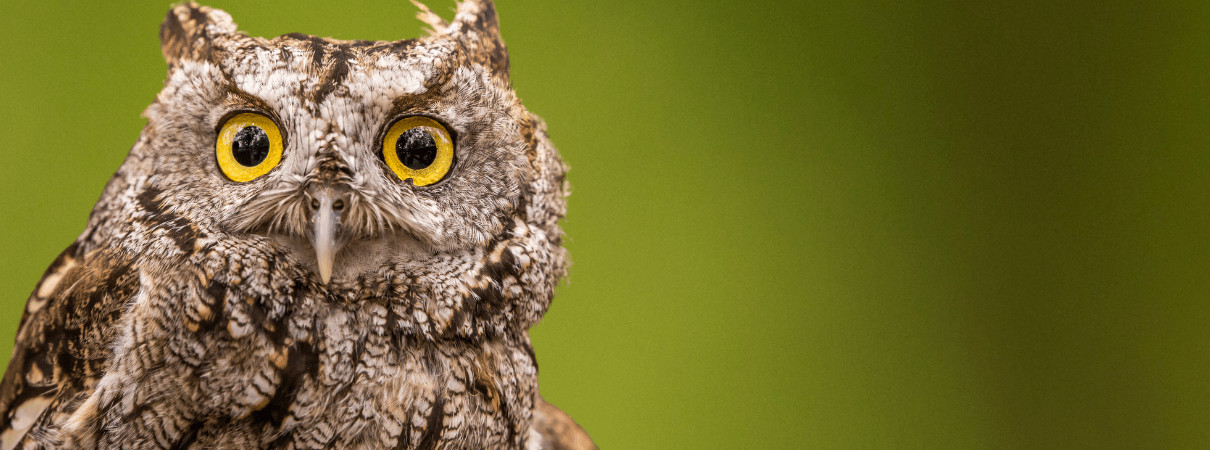 Western Screech Owl By lalcreative/Shutterstock
Western Screech Owl By lalcreative/Shutterstock
Western Screech-Owls look almost identical to their eastern counterparts, but their call is different. Instead of a whinny or a trill, they produce a series of hoots that speed up toward the end, like a bouncing ball settling to the ground. Found west of the Rockies, these owls are doing well overall, although one subspecies along the Pacific coast is listed as Endangered in Canada.
Research from the Canadian Wildlife Service indicates that the Pacific coast subspecies of the Western Screech-Owl faces unique threats from habitat fragmentation and urbanization. Monitoring their distinct vocalizations is essential for tracking their population status.
8. The Northern Saw-whet Owl’s Toot-Toot-Toot
Northern Saw-whet Owls get their name from their sounds. One of their calls, the repetitive “toot-toot-toot-toot” males use to announce their presence, reminded early ornithologists of the sound of a saw being sharpened on a whetstone. These tiny owls prefer coniferous forests but can be found in various forest types in North America. Although their populations are declining, their secretive and exclusively nocturnal behaviors make them hard to study.
The Northern Saw-whet Owl’s unique call is a key identifier for researchers, according to studies from the National Audubon Society. Their secretive nature makes acoustic monitoring essential for understanding their distribution and population trends.
9. The Far-Reaching Hoots of the Snowy Owl
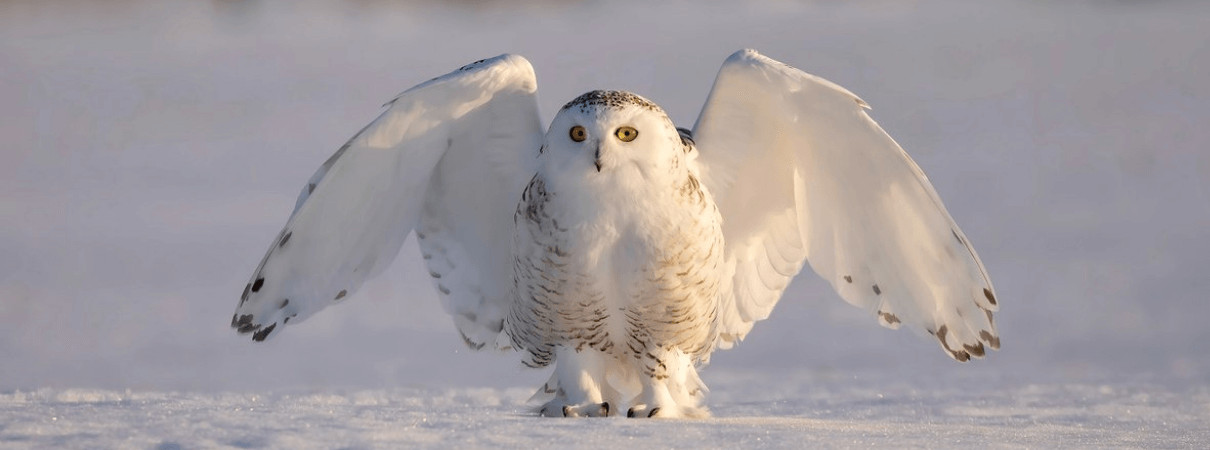 Snowy Owl by Jim Cummings/Shutterstock
Snowy Owl by Jim Cummings/Shutterstock
The deep, hoarse hoots of the Snowy Owl can be heard from up to seven miles away on the open Arctic tundra. Famous for their white plumage, Snowy Owls have a circumpolar range, spanning northern regions of Eurasia and North America. The IUCN Red List categorizes this species as Vulnerable, and it stands to lose about half of its current North American habitat if the climate warms by 1.5 degrees Celsius.
Climate change poses a significant threat to Snowy Owls, as highlighted by the IUCN Red List. Their long-range vocalizations are essential for communication in their vast, open habitats, making them vulnerable to noise pollution and habitat degradation.
10. The Tiny Yips of the Elf Owl
The smallest owl in the world, the Elf Owl, lives in the woodlands and Saguaro cactus-studded deserts of the southwestern U.S. and Mexico. This species’ “chatter song” consists of a fast series of five to seven high-pitched notes that some have compared to the yipping of a small dog. Now rare in some parts of their range, Elf Owls are declining due to habitat loss and are listed as Endangered in California.
The Elf Owl’s unique vocalizations are critical for communication in their arid environments, as noted by the California Department of Fish and Wildlife. Their decline underscores the importance of habitat preservation and conservation efforts.
11. The Role of Owl Sounds in Urban Soundscapes
The sounds of owls contribute significantly to the urban soundscapes of many cities across the United States. These nocturnal calls add a layer of mystery and nature to otherwise human-dominated environments. From the hooting of the Great Horned Owl to the screech of the Eastern Screech-Owl, these sounds can evoke a sense of wonder and connection to the natural world.
11.1. Owls in New York City
Even in a bustling metropolis like New York City, owl sounds can be heard in parks and green spaces. The presence of owls indicates a healthy ecosystem, providing a natural form of pest control by preying on rodents and other small animals. Hearing an owl in the city can be a surprising and delightful experience for urban dwellers.
11.2. Owls in Los Angeles
In Los Angeles, the calls of owls such as the Barn Owl and Western Screech-Owl can be heard in residential neighborhoods and urban parks. These owls adapt to the urban environment by nesting in trees, buildings, and other structures. Their presence contributes to the biodiversity of the city and provides opportunities for urban nature enthusiasts to observe and appreciate wildlife.
11.3. The Impact of Urban Noise on Owl Communication
Urban noise pollution can significantly impact owl communication. High levels of noise can mask their calls, making it difficult for them to attract mates, defend territories, and communicate with their young. Efforts to reduce urban noise pollution, such as implementing noise barriers and promoting quieter technologies, can help protect owl populations in urban areas.
12. How Streetsounds.net Helps You Discover Owl Sounds
Streetsounds.net offers a comprehensive platform for exploring and understanding owl sounds. With a vast library of high-quality recordings, detailed articles, and a passionate community of sound enthusiasts, Streetsounds.net is your ultimate resource for all things related to urban soundscapes.
12.1. Extensive Sound Library
Streetsounds.net features an extensive library of owl sound recordings, captured in various urban and natural environments. Each recording is carefully curated and annotated, providing detailed information about the species, location, and context of the sound. You can easily browse and listen to these recordings, allowing you to familiarize yourself with the unique calls of different owl species.
12.2. Informative Articles and Guides
Streetsounds.net provides a wealth of informative articles and guides about owl sounds. These resources cover a wide range of topics, including owl identification, vocalization behavior, and the role of owls in urban ecosystems. Whether you’re a seasoned ornithologist or a curious beginner, you’ll find valuable information to enhance your understanding and appreciation of owl sounds.
12.3. Community Engagement
Streetsounds.net fosters a vibrant community of sound enthusiasts, where you can connect with like-minded individuals, share your own recordings and observations, and participate in discussions about urban soundscapes. This community provides a supportive and collaborative environment for learning and exploration.
13. The Cultural Significance of Owl Sounds
Owl sounds hold deep cultural significance in many societies around the world. These nocturnal calls are often associated with wisdom, mystery, and the supernatural. In some cultures, owls are revered as symbols of knowledge and insight, while in others, they are seen as omens of misfortune or death.
13.1. Owl Sounds in Mythology
In Greek mythology, the owl is associated with Athena, the goddess of wisdom and strategic warfare. The owl’s keen eyesight and silent flight symbolize knowledge and insight. In many Native American cultures, owls are seen as protectors and guides, with their calls carrying messages from the spirit world.
13.2. Owl Sounds in Literature and Art
Owl sounds have inspired countless works of literature and art. From Edgar Allan Poe’s “The Raven” to J.K. Rowling’s “Harry Potter” series, owls are often portrayed as mysterious and enigmatic creatures. Their calls add a sense of atmosphere and intrigue to stories and films, enhancing the overall emotional impact.
13.3. The Use of Owl Sounds in Music
Owl sounds have been incorporated into various musical genres, from classical compositions to electronic music. These sounds can evoke a sense of nature, mystery, and introspection. Composers and musicians often use owl sounds to create a unique sonic landscape, adding depth and complexity to their works.
14. How to Record Owl Sounds
Recording owl sounds can be a challenging but rewarding experience. To capture high-quality recordings, you’ll need the right equipment and techniques. Here are some tips to help you get started:
14.1. Equipment
- Microphone: A high-quality microphone is essential for capturing clear and detailed recordings. Consider using a shotgun microphone or a binaural microphone for directional and immersive sound capture.
- Recorder: A portable audio recorder with adjustable gain and phantom power is necessary for recording owl sounds in the field.
- Headphones: Headphones allow you to monitor the recording in real-time and ensure that you’re capturing the desired sounds without interference.
- Windscreen: A windscreen is crucial for reducing wind noise, especially when recording outdoors.
14.2. Techniques
- Location: Choose a quiet location with minimal background noise. Parks, forests, and rural areas are ideal for recording owl sounds.
- Timing: Owls are most active at night, so plan your recording sessions accordingly. Dawn and dusk are also good times to capture their calls.
- Patience: Recording owl sounds requires patience and persistence. Be prepared to spend several hours in the field to capture the sounds you’re looking for.
- Ethics: Always respect the owls and their habitat. Avoid disturbing them or interfering with their natural behavior.
14.3. Post-Processing
- Noise Reduction: Use audio editing software to reduce background noise and enhance the clarity of the owl sounds.
- Equalization: Adjust the equalization to balance the frequencies and create a more natural sound.
- Mastering: Master the recording to optimize the overall loudness and dynamic range.
15. The Impact of Climate Change on Owl Sounds
Climate change is having a profound impact on owl populations and their habitats. As temperatures rise and ecosystems shift, owls are facing new challenges in terms of food availability, breeding success, and habitat suitability.
15.1. Changes in Habitat
Climate change is causing significant changes in owl habitats, such as forests, grasslands, and wetlands. These changes can affect the availability of prey species, nesting sites, and overall habitat quality. As owls struggle to adapt to these changes, their populations may decline, and their vocalization behavior may be altered.
15.2. Altered Vocalization Behavior
Climate change can affect owl vocalization behavior in several ways. Changes in temperature, humidity, and wind patterns can influence the propagation of sound, making it more difficult for owls to communicate effectively. Additionally, shifts in prey availability and breeding patterns can alter the timing and frequency of owl calls.
15.3. Conservation Efforts
To mitigate the impacts of climate change on owl populations, it’s essential to implement effective conservation strategies. These strategies may include habitat restoration, climate-smart management practices, and efforts to reduce greenhouse gas emissions. By protecting owl habitats and reducing the effects of climate change, we can help ensure the survival of these iconic birds and their distinctive sounds.
16. The Future of Owl Sound Research
Owl sound research is a rapidly evolving field, with new technologies and techniques enabling scientists to study owl vocalizations in unprecedented detail. From acoustic monitoring to machine learning, these advances are providing new insights into owl behavior, communication, and ecology.
16.1. Acoustic Monitoring
Acoustic monitoring involves the use of automated recording devices to capture owl sounds over extended periods. This technology allows researchers to track owl populations, monitor their vocalization behavior, and assess the impacts of environmental changes. Acoustic monitoring is becoming an increasingly important tool for owl conservation and management.
16.2. Machine Learning
Machine learning algorithms can be used to analyze owl sound recordings and identify patterns that are difficult for humans to detect. These algorithms can classify owl species, identify individual birds, and even predict their behavior based on their vocalizations. Machine learning is revolutionizing the field of owl sound research, enabling scientists to analyze large datasets and uncover new insights into owl communication.
16.3. Citizen Science
Citizen science initiatives engage volunteers in the collection and analysis of owl sound data. These projects provide valuable opportunities for the public to learn about owls and contribute to scientific research. By participating in citizen science projects, individuals can help monitor owl populations, identify important habitats, and promote owl conservation.
17. The Ethical Considerations of Owl Sound Recording
While recording owl sounds can be a rewarding experience, it’s important to consider the ethical implications of this activity. Owls are sensitive to disturbance, and excessive noise or intrusion can disrupt their natural behavior and harm their populations.
17.1. Minimizing Disturbance
When recording owl sounds, it’s essential to minimize disturbance to the birds and their habitat. Avoid approaching owls too closely, making loud noises, or using bright lights. Stay on established trails and respect any closures or restrictions in place to protect owl populations.
17.2. Obtaining Permits
In some areas, it may be necessary to obtain permits before recording owl sounds. Check with local wildlife agencies or park authorities to determine whether permits are required and to learn about any specific guidelines or restrictions.
17.3. Sharing Responsibly
When sharing owl sound recordings, be mindful of the potential impacts on owl populations. Avoid disclosing the exact location of owl nesting sites or sensitive habitats, as this could attract unwanted attention or disturbance.
18. The Best Times and Places to Hear Owl Sounds in the US
Knowing when and where to listen can greatly increase your chances of hearing owls. Owls are most vocal during their breeding season, which typically occurs in late winter and early spring. Here are some of the best times and places to listen for owls in the US:
18.1. Timing
- Late Winter/Early Spring: This is the peak breeding season for many owl species, making it the best time to hear their courtship calls and territorial displays.
- Dawn and Dusk: Owls are most active during these twilight hours, so plan your listening sessions accordingly.
- Clear Nights: Owls are more likely to vocalize on clear, calm nights with little wind or rain.
18.2. Locations
- National Parks: Parks like Yellowstone, Yosemite, and Great Smoky Mountains National Park offer vast expanses of suitable owl habitat and relatively low levels of human disturbance.
- National Forests: National Forests provide diverse habitats and opportunities to hear a variety of owl species.
- Wildlife Refuges: Wildlife Refuges are managed specifically for wildlife conservation and offer excellent opportunities to hear owls in their natural environment.
- Local Parks and Green Spaces: Even urban and suburban parks can provide habitat for owls, particularly if they contain mature trees and wooded areas.
19. Owl Sounds and Their Connection to Street Sounds
While often associated with rural or natural environments, owl sounds can sometimes be heard amidst the urban soundscape, creating an interesting juxtaposition between nature and the city. The presence of owl sounds in urban environments can evoke a sense of wonder and connection to the natural world.
19.1. Contrasting Soundscapes
The sounds of owls can provide a stark contrast to the noise of the city, offering a moment of tranquility amidst the hustle and bustle. Hearing an owl hoot in the middle of a busy city street can be a surprising and memorable experience.
19.2. The Harmony of Urban and Natural Sounds
In some cases, owl sounds can blend with the sounds of the city, creating a unique and harmonious soundscape. The hooting of an owl might intermingle with the distant hum of traffic or the chatter of people, adding a layer of depth and complexity to the urban environment.
19.3. Using Owl Sounds in Urban Sound Art
Artists and sound designers are increasingly using owl sounds in urban sound art installations, creating immersive and thought-provoking experiences for urban dwellers. These installations can raise awareness about the importance of urban biodiversity and the connection between humans and nature.
20. How to Help Owls Thrive in Urban Environments
Even in urban environments, there are things you can do to help owls thrive. By providing suitable habitat, reducing threats, and promoting awareness, you can make a positive impact on owl populations in your community.
20.1. Provide Habitat
- Plant Native Trees and Shrubs: Native plants provide food and shelter for owls and their prey.
- Install Nest Boxes: Nest boxes can provide suitable nesting sites for owls in areas where natural cavities are scarce.
- Create Wildlife-Friendly Gardens: Avoid using pesticides and herbicides, and provide sources of water for owls and their prey.
20.2. Reduce Threats
- Keep Cats Indoors: Cats are a major threat to owls and other birds, so keep them indoors or supervise them when they’re outside.
- Reduce Light Pollution: Excessive light pollution can disrupt owl behavior and make it difficult for them to hunt. Use shielded light fixtures and minimize unnecessary lighting.
- Drive Carefully: Owls are often killed by cars while hunting along roads, so drive carefully and be aware of wildlife.
20.3. Promote Awareness
- Educate Your Neighbors: Share information about owls and how to help them thrive in urban environments.
- Support Local Conservation Organizations: Donate to or volunteer with organizations that are working to protect owls and their habitats.
- Participate in Citizen Science Projects: Help monitor owl populations and contribute to scientific research.
Explore the captivating realm of owl sounds at streetsounds.net. Our extensive collection offers a gateway to understanding and appreciating these remarkable creatures. By immersing yourself in their unique vocalizations, you’ll gain a deeper connection to the natural world.
FAQ: Decoding the Sounds of Owls
1. What is the most common owl sound?
The most common owl sound is the classic “hoo,” typically associated with the Great Horned Owl.
2. Why do owls hoot?
Owls hoot to communicate, establish territory, attract mates, and warn off rivals.
3. Do all owls make the same sound?
No, different species of owls have distinct calls, ranging from hoots and whistles to screeches and barks.
4. What does it mean when an owl hoots at night?
When an owl hoots at night, it’s usually marking its territory or trying to attract a mate.
5. How can I identify an owl by its sound?
You can identify an owl by its sound by learning the unique calls of different species, often available on websites like streetsounds.net.
6. What is the purpose of owl sounds in nature?
The purpose of owl sounds is to facilitate communication, hunting, and survival in their nocturnal environment.
7. Are owl sounds different in urban vs. rural areas?
While the basic calls remain the same, urban noise pollution can affect the clarity and audibility of owl sounds.
8. How far can owl sounds travel?
Owl sounds can travel varying distances depending on the species and environmental conditions, but some can be heard from miles away.
9. Can humans imitate owl sounds?
Yes, some people can imitate owl sounds, often used for birdwatching or to attract owls.
10. What should I do if I hear an unusual owl sound?
If you hear an unusual owl sound, it could indicate a rare species or distress, and reporting it to local wildlife authorities can be helpful.
Ready to enrich your projects with authentic urban sounds? Visit streetsounds.net today and explore our extensive sound library, delve into fascinating articles, and join our community of sound enthusiasts. Don’t miss out—connect, create, and discover the world of sound with streetsounds.net.
Address: 726 Broadway, New York, NY 10003, United States
Phone: +1 (212) 998-8550
Website: streetsounds.net


